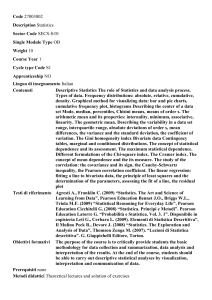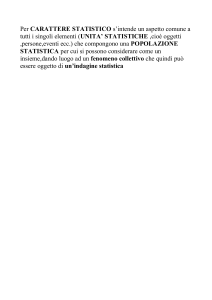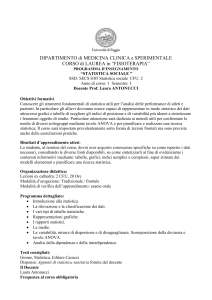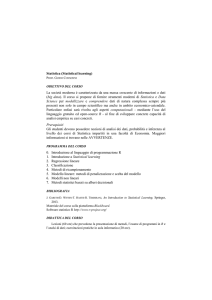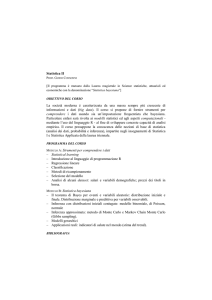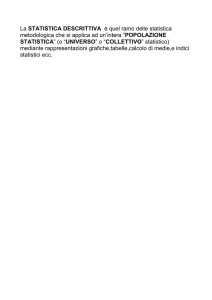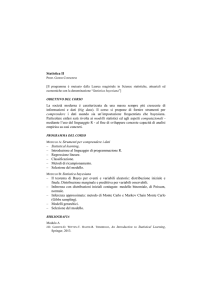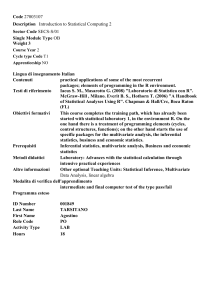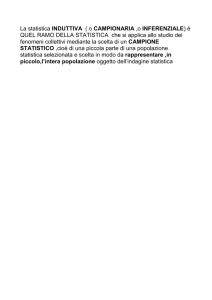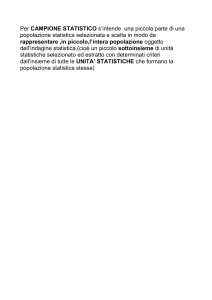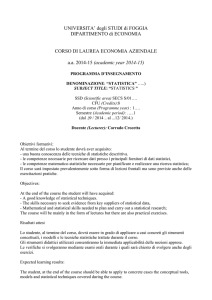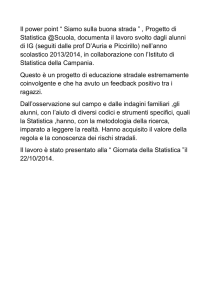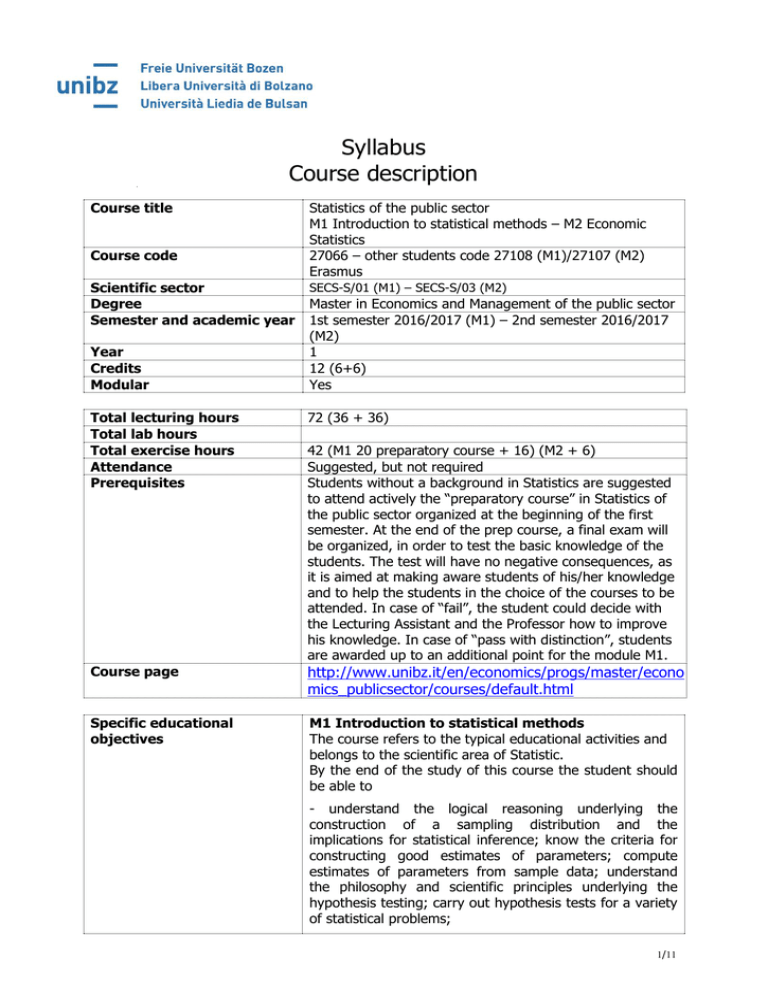
Syllabus
Course description
Course title
Course code
Scientific sector
Degree
Semester and academic year
Year
Credits
Modular
Statistics of the public sector
M1 Introduction to statistical methods – M2 Economic
Statistics
27066 – other students code 27108 (M1)/27107 (M2)
Erasmus
SECS-S/01 (M1) – SECS-S/03 (M2)
Master in Economics and Management of the public sector
1st semester 2016/2017 (M1) – 2nd semester 2016/2017
(M2)
1
12 (6+6)
Yes
Total lecturing hours
Total lab hours
Total exercise hours
Attendance
Prerequisites
72 (36 + 36)
Course page
http://www.unibz.it/en/economics/progs/master/econo
mics_publicsector/courses/default.html
Specific educational
objectives
M1 Introduction to statistical methods
The course refers to the typical educational activities and
belongs to the scientific area of Statistic.
By the end of the study of this course the student should
be able to
42 (M1 20 preparatory course + 16) (M2 + 6)
Suggested, but not required
Students without a background in Statistics are suggested
to attend actively the “preparatory course” in Statistics of
the public sector organized at the beginning of the first
semester. At the end of the prep course, a final exam will
be organized, in order to test the basic knowledge of the
students. The test will have no negative consequences, as
it is aimed at making aware students of his/her knowledge
and to help the students in the choice of the courses to be
attended. In case of “fail”, the student could decide with
the Lecturing Assistant and the Professor how to improve
his knowledge. In case of “pass with distinction”, students
are awarded up to an additional point for the module M1.
- understand the logical reasoning underlying the
construction of a sampling distribution and the
implications for statistical inference; know the criteria for
constructing good estimates of parameters; compute
estimates of parameters from sample data; understand
the philosophy and scientific principles underlying the
hypothesis testing; carry out hypothesis tests for a variety
of statistical problems;
1/11
- understand and use descriptive and inferential statistics
when i) there is a single quantitative response variable
and a single explanatory variable and ii) there is a single
quantitative response variable and a set of explanatory
variables;
- understand the concept of distance and dissimilarity
between two observations and the use of the clustering
algorithms to group together observations similar to each
other and find meaningful structure into the data;
- understand the concept of principal component and
perform dimensionality reduction following the approach
of the principal component analysis;
- develop the ability to perform basic statistical data
analysis by means of the R software.
M2 Economic Statistics
The course refers to the typical educational activities and
belongs to the scientific area of Applied Statistic.
By the end of the study of this course the student should
be able to
- interpret and use relevant index numbers in economics
and demography;
- understand and use statistical and computational
elements for forecasting the future values of socioeconomic phenomena and demography related issues.
Module 1
Lecturer
M1 Introduction to statistical methods
Francesca Marta Lilja Di Lascio
Office E510a
e-mail: [email protected]
Tel: 0471/013285
http://www.unibz.it/en/economics/people/StaffDetails
.html?personid=32845&hstf=32845
Scientific sector of the
lecturer
Teaching language
Office hours
Lecturing assistant
SECS-S/01
Italian
Please refer to the lecturer’s web page
Enrico Foscolo (preparatory course)
Office E208
e-mail: [email protected]
Tel: 0471/013499
http://www.unibz.it/en/economics/people/StaffDetails
.html?personid=32407&hstf=32407
Gloria Gheno (exercise course)
http://www.unibz.it/en/economics/people/StaffDetails
2/11
.html?personid=36980&hstf=36980
Teaching assistant
Office hours
List of topics covered
not foreseen
Please refer to the lecturer’s web page
Statistical Inference
Inductive process under uncertainty. Sampling and
sampling distributions of the mean, variance and
proportion. Statistics, estimators and their properties.
Choice of an estimator. Point estimation and confidence
intervals for the mean, the variance and the proportion.
Hypothesis testing. Type I error and type II error. Power
of the test. Significance level and p-value. Hypothesis tests
for the mean of a normal population and for a proportion.
Hypothesis testing for two means of normal populations
and in the case of large samples. Test of independence.
Statistical Models and Multivariate Analysis
Techniques
The simple linear regression model. The multivariate
regression model. Cluster analysis: k-means and
hierarchical clustering. Principal component analysis.
R software
Introduction to R. Statistical data analysis by R.
Teaching format
Frontal lectures, exercises, lectures with computers
Module 2
Lecturer
M2 Economic Statistics
Enrico Foscolo
Office E208
e-mail: [email protected]
Tel: 0471/013499
http://www.unibz.it/en/economics/people/StaffDetails
.html?personid=32407&hstf=32407
Scientific sector of the
lecturer
Teaching language
Office hours
Lecturing assistant
Teaching assistant
Office hours
List of topics covered
SECS-S/03
Italian
Please refer to the lecturer’s web page
Not foreseen
Not foreseen
Time Series
Introduction; representation; trend; seasonality; cycles;
forecasting techniques.
Economic Statistics
Economic data: Concepts, definitions and classification of
economic statistics. Statistical indices.
Demography
Demographic data, population size and distribution,
3/11
Teaching format
population dynamics.
Frontal lectures, exercises, lectures with computers
Learning outcomes
M1 Introduction to statistical methods
Knowledge and understanding: Knowledge of the basics of
the inferential statistical theory, from the estimation to the
test of hypothesis. Knowledge of the procedure of simple
and multivariate linear statistical modelling, clustering
algorithms and methods for dimensionality reduction.
Applying knowledge and understanding: Ability to perform
statistical analysis of socio-economic data through both
the descriptive and the inferential statistical tools as well
as linear regression model and other multivariate analysis
techniques like clustering and principal component
analysis. Ability to perform all the mentioned statistical
techniques by using an appropriate statistical software.
Making judgments on the appropriate statistical tools to
analyse data and on the results of a statistical analysis.
Communication skills to present in a consistent and
precise way the results obtained from a statistical analysis
of observed data.
Learning skills: Ability to understand the logic of the
statistical reasoning and to interpret the results of
statistical analysis.
M2 Economic Statistics
Knowledge and understanding: Knowledge of the basics of
index numbers, time series, and demography.
Applying knowledge and understanding: Ability to evaluate
temporal changes in some relevant socio-economic
phenomena, such as the gross domestic product, the
unemployment, and the industrial production; ability to
analyse demography related issues. Understand how to
measure the inflation.
Making judgments: Ability to write a technical report on
specific economic issues by analysing data and extracting
the underlying dynamics.
Communication skills: Ability to present in a consistent
and precise way the results obtained from the statistical
analysis.
Learning skills: Ability to understand and analyse the
4/11
economic data from a quantitative perspective.
Assessment
Assessment language
Evaluation criteria and
criteria for awarding marks
M1 Introduction to statistical methods
Written and project work:
- Attending students: final written examination with
exercises and theoretical questions; presentation of group
projects related to the use of the statistical software R.
- Not-attending students: final written examination with
exercises and theoretical questions; presentation of an
individual project related to the use of the statistical
software R (please, contact the teacher in advance).
M2 Economic Statistics
Written and project work:
- Attending students: final written examination with
exercises and theoretical questions; presentation of group
projects related to the use of the statistical software R.
- Not-attending students: final written examination with
exercises and theoretical questions; presentation of an
individual project related to the use of the statistical
software R (please, contact the teacher in advance).
Italian
M1 Introduction to statistical methods
To pass the M1 module exam students must obtain a
positive evaluation on both the written exam and the
project. Otherwise, the test is considered failed. The
evaluation of the written exam weights about 50% as well
as the evaluation of the project work.
Pass with distinction in the prep class: up to 1 point.
M2 Economic Statistics
To pass the M2 module exam students must obtain a
positive evaluation on both the written exam and the
project. Otherwise, the test is considered failed. The
evaluation of the written exam weights about 50% as well
as the evaluation of the project work.
Required readings
M1 Introduction to statistical methods
- S. Borra, A. Di Ciaccio, Statistica – metodologie per le scienze
economiche e sociali, McGraw-Hill, pp. 513, Milano, 2014. ISBN:
978-88-386-6740-4. Chapters: 10-14, 16-17.
- A. Cerioli, S. Zani, Analisi dei dati e data mining per le
decisioni aziendali, Giuffrè, pp. 626, Milano, 2007. ISBN:
9788814136955. Chapters: 6, 8-9.
- Lecture notes and R code of the labs will be provided.
M2 Economic Statistics
- E. Giovannini, Le Statistiche Economiche, Il Mulino, 2006.
- G.C. Blangiardo, Elementi di Demografia, Il Mulino, 2006.
- P.S.P. Cowpertwait, A.V. Metcalfe, Introductory Time Series
with R, Springer, 2009.
5/11
- Lecture notes and R code of the labs will be provided.
Supplementary readings
M1 Introduction to statistical methods
- P. Newbold, W. L. Carlson, B. Thorne, Statistica, PearsonPrentice Hall, Milano, 2011. ISBN 978-88-719-2744-2.
- Cicchitelli, G., Statistica – Principi e metodi, Pearson, pp. 622,
Milano, 2012. ISBN: 978-88-719-2770-1.
- T. Hastie, R. Tibshirani, J. Friedman, The elements of
statistical learning, Springer Science + Business Media, LLC,
2013.
Available
on
the
web
at
http://statweb.stanford.edu/~tibs/ElemStatLearn/.
M2 Economic Statistics
- Further readings will be announced during the course.
Syllabus
Descrizione dell’insegnamento
Titolo dell’insegnamento
Codice dell’insegnamento
Settore scientifico
disciplinare
dell’insegnamento
Corso di studio
Semestre e anno
accademico
Anno dell’insegnamento
Crediti formativi
Modulare
Numero totale di ore di
lezione
Numero totale di ore di
laboratorio
Numero totale di ore di
esercitazioni
Frequenza
Insegnamenti propedeutici
Statistica del settore pubblico
M1 Metodi e principi di statistica – M2 Statistica
economica
27066 – codice per studenti esterni 27108 (M1)/27107
(M2) Erasmus
SECS-S/01 (M1) – SECS-S/03 (M2)
Economia e Management del Settore pubblico
1° semestre 2016/2017 (M1) – 2° semestre 2016/2017
(M2)
1
12 (6+6)
Sì
72 (36 + 36)
42 (M1 20 corso preparatorio + 16) (M2 + 6)
Consigliata ma non obbligatoria
Non sono previste propedeuticità. Si suggerisce però agli
studenti senza adeguata formazione in statistica di
frequentare il corso preparatorio in Statistica per il settore
pubblico organizzato all’inizio del primo semestre. Alla fine
del precorso si terrà un esame finale di verifica delle
conoscenze iniziali. L’esame non avrà conseguenze
negativa, e dovrà servire per orientare lo studente nella
6/11
scelta dei corsi da seguire. In caso di esito negativo lo
studente potrà concordare con l’esercitatore e il docente
del corso una strategia di compensazione.
In caso di esito molto positivo, si prevede l’assegnazione
fino a un massimo di 1 punto aggiuntivo per il modulo M1.
Sito web dell’insegnamento
http://www.unibz.it/en/economics/progs/master/econ
omics_publicsector/courses/default.html
Obiettivi formativi specifici
dell’insegnamento
M1 Metodi e principi di statistica
Questo insegnamento rientra tra le attività formative
caratterizzanti e, nello specifico, appartiene all’ambito
disciplinare statistico.
Alla fine dello studio di questo corso lo studente dovrebbe
essere in grado di
- capire la logica che è alla base della costruzione di una
distribuzione campionaria; comprendere i criteri per la
costruzione di una buona stima dei parametri incogniti di
una popolazione, calcolare le stime dei parametri,
descrivere la filosofia e principi scientifici alla base della
verifica delle ipotesi ed effettuare test di ipotesi per una
serie di problemi statistici;
- comprendere e usare il modello di regressione lineare
semplice e multivariato sia da un punto di vista descrittivo
che inferenziale;
- comprendere il concetto di distanza e di dissimilarità tra
due osservazioni e l'uso di algoritmi di clustering atti ad
identificare strutture nei dati;
- comprendere il concetto di componente principale e
ridurre la dimensione dei dati attraverso l'analisi in
componenti principali;
- sviluppare la capacità di realizzare analisi statistiche dei
dati utilizzando il software R.
M2 Statistica economica
Questo insegnamento rientra tra le attività formative
caratterizzanti e, nello specifico, appartiene all’ambito
disciplinare della statistica applicata.
Alla fine dello studio di questo corso lo studente dovrebbe
essere in grado di
- interpretare e usare i numeri indici più rilevanti
nell’ambito dell’economia e della demografia;
- comprendere ed usare gli elementi statistici e
computazionali per prevedere i valori futuri di aggregati
economici e demografici.
Modulo 1
Docente
M1 Metodi e principi di statistica
Francesca Marta Lilja Di Lascio
Office E-510a
e-mail: [email protected]
Tel: 0471/013285
7/11
http://www.unibz.it/en/economics/people/StaffDetails.
html?personid=32845&hstf=32845
Settore scientifico
disciplinare del docente
Lingua ufficiale
dell’insegnamento
Orario di ricevimento
Esercitatore
SECS-S/01
Italiano
Vedi sito web del docente
Enrico Foscolo (corso preparatorio)
Office E208
e-mail: [email protected]
Tel: 0471/013499
http://www.unibz.it/en/economics/people/StaffDetails
.html?personid=32407&hstf=32407
Gloria Gheno (exercise course)
http://www.unibz.it/en/economics/people/StaffDetails
.html?personid=36980&hstf=36980
Collaboratore didattico
Orario di ricevimento
Lista degli argomenti
trattati
Non previsto
Inferenza Statistica
Processo
induttivo
in
condizioni
di
incertezza.
Campionamento
casuale
semplice
e
distribuzioni
campionarie della media, della varianza e della
proporzione. Statistiche campionarie, stimatori e loro
proprietà. Scelta di uno stimatore. Stima puntuale ed
intervalli di confidenza per la media, per la varianza e per
una proporzione. Test di ipotesi. Errore di I e di II tipo.
Potenza del test. Livello di significatività e p-value. Test di
ipotesi per la media di una popolazione normale e per una
proporzione. Test d'ipotesi per il confronto di due medie di
popolazioni normali e nel caso di grandi campioni. Test di
indipendenza.
Modelli statistici e tecniche statistiche di analisi
multivariata
Modello di regressione lineare semplice e multivariato.
Analisi dei gruppi: k-medie e metodi gerarchici. Analisi
delle componenti principali.
Attività didattiche previste
Modulo 2
Docente
Software R
Introduzione a R. Analisi statistica dei dati con R.
Lezioni frontali, esercitazioni e lezioni al computer.
M2 Statistica economica
Enrico Foscolo
Office E208
e-mail: [email protected]
Tel: 0471/013499
http://www.unibz.it/en/economics/people/StaffDetails
.html?personid=32407&hstf=32407
8/11
Settore scientifico
disciplinare del docente
Lingua ufficiale
dell’insegnamento
Orario di ricevimento
Esercitatore
Collaboratore didattico
Orario di ricevimento
Lista degli argomenti
trattati
SECS-S/03
italiano
Vedi sito web del docente
Non previsto
Non previsto
Serie storiche
Introduzione; rappresentazione; trend; stagionalità; ciclo;
tecniche di previsione.
Statistiche economiche
Dati economici: concetti, definizioni e classificazione delle
statistiche economiche. Indici statistici.
Attività didattiche previste
Demografia
Dati relativi alla popolazione, sua ampiezza e distribuzione,
nonché analisi delle dinamiche evolutive.
Lezioni frontali, esercitazioni e lezioni al computer.
Risultati di apprendimento M1 Metodi e principi di statistica
attesi
Conoscenza e capacità di comprensione della teoria
statistica inferenziale, dalla teoria della stima ai test di
ipotesi. Conoscenza della procedura di utilizzo del modello
di regressione lineare semplice e di quello multivariato.
Conoscenza di alcune tecniche di analisi statistica
multivariata utili per ridurre la dimensione dei dati e/o per
trovare strutture sottostanti i dati osservati.
Capacità di applicare conoscenza e comprensione:
Capacità di realizzare analisi statistiche di dati di interesse
socio-economico imparando a organizzare un database, ad
analizzare dati sia da un punto di vista descrittivo che
inferenziale attraverso modelli di regressione lineare e
tecniche di analisi multivariata come l'analisi dei gruppi e
quella in componenti principali, usando appropriati
software statistici.
Autonomia di giudizio sull'appropriato strumento statistico
da utilizzare per l'analisi di un data set e sulla valutazione
e dei risultati derivanti da un'analisi.
Abilità comunicative nel presentare in maniera coerente e
precisa la metodologia utilizzata per svolgere un'analisi
statistica e i risultati derivanti da essa.
Capacità di apprendimento: Abilità nel comprendere la
logica del ragionamento statistico e di interpretare i
risultati di un'analisi statistica di dati osservati.
9/11
M2 Statistica economica
Conoscenza e capacità di comprensione: competenze utili
all’analisi statistica di variabili socio-economiche e
demografiche.
Capacità di applicare conoscenza e comprensione: abilità
nel valutare i cambiamenti temporali intercorsi fra le
variabili più rilevanti dal punto di vista socio-economico,
quali prodotto interno lordo, disoccupazione, produzione
industriale, nonché fra quelle di natura demografica. Lo
studente inoltre comprende come misurare ed interpretare
il tasso d’inflazione.
Autonomia di giudizio: abilità nel produrre report su
specifiche tematiche socio-economiche e demografiche
con l’ausilio dei dati e nel sintetizzarne le principali
caratteristiche.
Abilità comunicative: abilità nel presentare in maniera
coerente e precisa i risultati derivanti dall’analisi statistica
del fenomeno allo studio.
Capacità di apprendimento: abilità nel leggere
nell’analizzare i dati di natura socio-economica
demografica seguendo un approccio quantitativo.
Metodo d’esame
Lingua dell’esame
Criteri di misurazione e
criteri di attribuzione del
voto
e
e
M1 Metodi e principi di statistica
Prova d'esame scritta e project work:
- Studenti frequentanti: esame scritto finale che consta di
esercizi e domande teoriche; presentazione di un progetto
di gruppo relativo all’uso del software R.
- Studenti non frequentanti: esame scritto finale che
consta di esercizi e domande teoriche; preparazione di un
progetto individuale relativo all’uso del software R (si
prega di contattare il docente).
M2 Statistica economica
Prova d'esame scritta e project work:
- Studenti frequentanti: esame scritto finale che consta di
esercizi e domande teoriche; presentazione di un progetto
di gruppo relativo all’uso del software R.
- Studenti non frequentanti: esame scritto finale che
consta di esercizi e domande teoriche; preparazione di un
progetto individuale relativo all’uso del software R (si
prega di contattare il docente).
Italiano
M1 Metodi e principi di statistica
Per superare il modulo M1 gli studenti devono ottenere
una valutazione positiva sia della prova scritta che del
10/11
progetto elaborato e presentato. La valutazione dell'esame
scritto pesa ca. il 50% sul voto finale così come la
valutazione del progetto svolto. Esito molto positivo al
corso preparatorio: fino a 1 punto aggiuntivo.
M2 Statistica economica
Per superare il modulo M2 gli studenti devono ottenere
una valutazione positiva sia della prova scritta che del
progetto elaborato e presentato. La valutazione dell'esame
scritto pesa ca. il 50% sul voto finale così come la
valutazione del progetto svolto.
Bibliografia fondamentale
Bibliografia consigliata
M1 Metodi e principi di statistica
- S. Borra, A. Di Ciaccio, Statistica – metodologie per le scienze
economiche e sociali, McGraw-Hill, pp. 513, Milano, 2014. ISBN:
978-88-386-6740-4. Capitoli: 10-14, 16-17.
- A. Cerioli, S. Zani, Analisi dei dati e data mining per le
decisioni aziendali, Giuffrè, pp. 626, Milano, 2007. ISBN:
9788814136955. Capitoli: 6, 8-9.
- Saranno fornite le slides delle lezioni, il codice dei laboratori.
M2 Statistica economica
- E. Giovannini, Le Statistiche Economiche, Il Mulino, 2006.
- G.C. Blangiardo, Elementi di Demografia, Il Mulino, 2006.
- P.S.P. Cowpertwait, A.V. Metcalfe, Introductory Time Series
with R, Springer, 2009.
- Saranno fornite le slides delle lezioni, il codice dei laboratori.
M1 Metodi e principi di statistica
- P. Newbold, W. L. Carlson, B. Thorne, Statistica, PearsonPrentice Hall, Milano, 2011. ISBN 978-88-719-2744-2.
- Cicchitelli, G., Statistica – Principi e metodi, Pearson, pp. 622,
Milano, 2012. ISBN: 978-88-719-2770-1.
- T. Hastie, R. Tibshirani, J. Friedman, The elements of
statistical learning, Springer Science + Business Media, LLC,
2013.
Disponibile
sul
web
la
seguente
indirizzo
http://statweb.stanford.edu/~tibs/ElemStatLearn/.
M2 Statistica economica
- Saranno forniti ulteriori testi e letture durante lo svolgimento
delle lezioni
11/11

